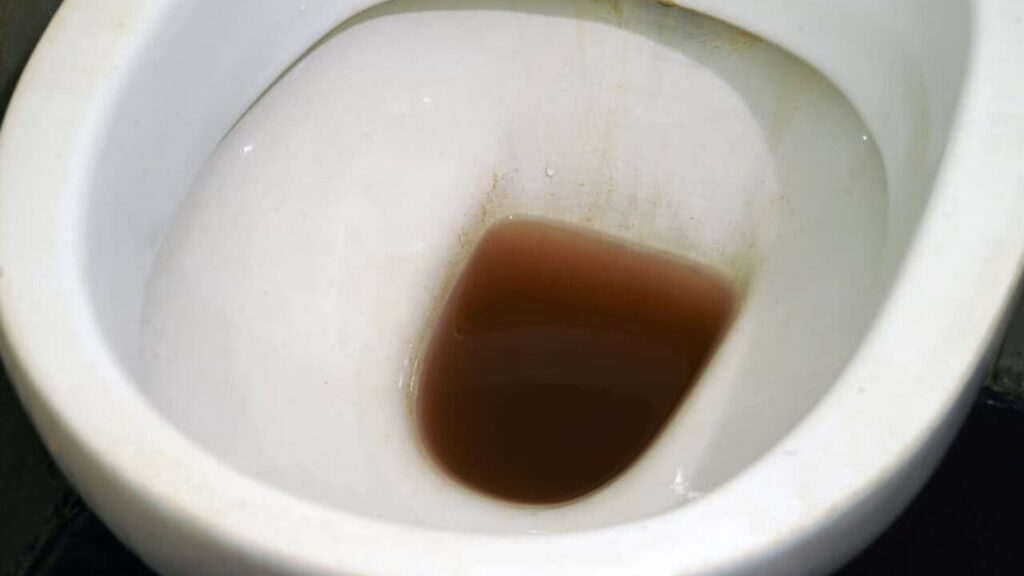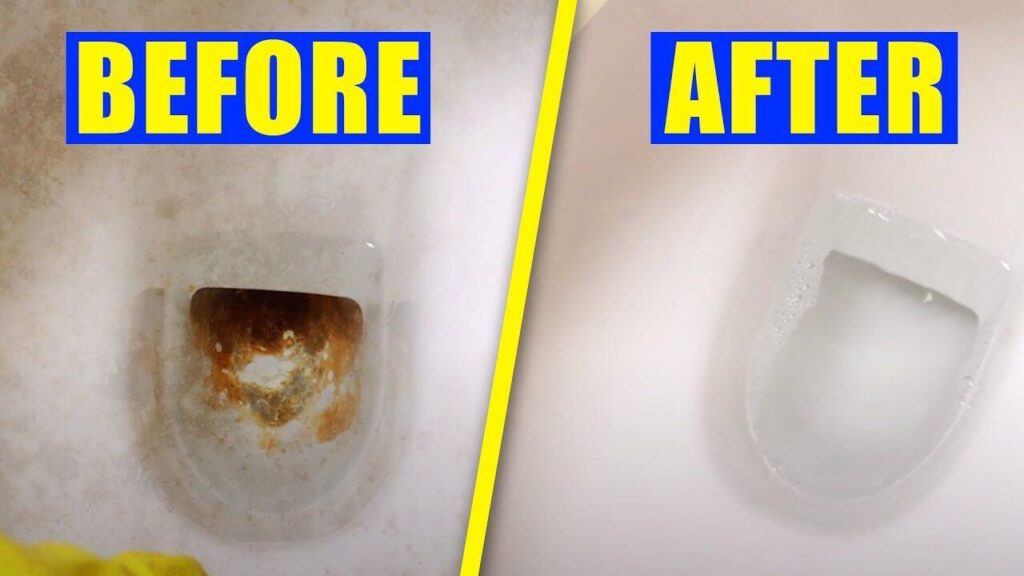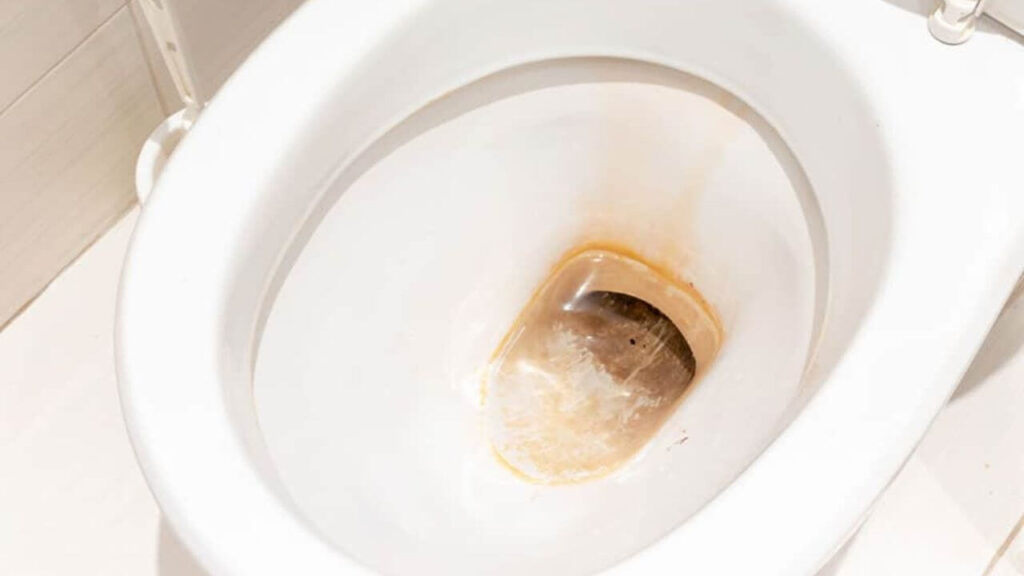I remember it like it was yesterday: It had been a long day of work, and I finally arrived home, exhausted.
As I shuffled into the bathroom to take a well-deserved shower.
I noticed something odd in the toilet bowl–the water inside was an unappealing shade of brown.
Concerned, confused, and determined to figure out what happened and how to fix it, I began trying to decipher why my toilet water had turned brown in the first place.
And in this article, I will share the possible reasons and ways to fix them I found. So keep reading.
Is Brown Water In a Toilet Dangerous?

Well, if you think brown water in a toilet is dangerous for you and your family, then here I am going to solve this enigma.
Brown water in a toilet can be dangerous. The longer answer depends on what is causing the discoloration and how it affects your health.
If the discoloration of your toilet water is due to rust or iron oxide deposits. Then there wouldn’t be an immediate danger to your health since these materials aren’t toxic.
However, they can leave a residue that might transfer onto objects like clothing and towels if you use them for personal hygiene purposes.
This substance could cause skin irritation in some people upon contact.
On the other hand, if the brownish color of your toilet water results from bacteria such as enterococci or fecal coliforms.
Then it could be much more severe as these types of bacteria are capable of carrying illnesses that range from mild stomach upset to severe vomiting and diarrhea even after just one exposure to contaminated food or drinking water.
Therefore, you must have any suspiciously colored toilet waters tested by a professional before using them again or coming into direct contact with them, lest you risk exposing yourself to potentially hazardous contaminants.
Why Is My Toilet Water Brown | Possible Reasons And Fixing

1) Rusted Pipes
Rusted pipes are one of the most common causes of brown toilet water.
The rust corrodes and wears away at the metal pipes, gradually creating particles that turn the regular tap water a distinctive brown or orange color.
Keeping an eye out for rust is essential to avoid any health risks.
Rust-filled water can become contaminated with minerals and lead, which is linked to several serious issues, including cancer, learning disabilities, infertility, and more.
Fixing:
One should start by closing the main water valve that supplies water to the toilet to fix this problem. This will stop the water supply, and any leaks caused by a faulty pipe will stop.
After this, the rusted pipes must be replaced with new pipes of an appropriate size and material.
The connections of these new pipes must be securely fastened using plumbers’ tape to ensure no noises are heard when flushing or draining.
Finally, once the work is complete, it is essential to open up the main water valve again and check for any signs of leakage or drips.
Follow these steps to successfully repair rusted pipes in a toilet and enjoy clear water again!
2) Leftover Waste In The Toilet
Another possible cause is leftover waste that has somehow made its way into the plumbing and remained undisturbed.
This stagnation of waste materials can tinge the water a brown color, although it will often take on an unpleasant odor or emit thick fumes when flushed.
Fixing:
To prevent this issue, users should practice inspecting their bathrooms frequently for clogs or flushing solids and large particles down the drain instead of sending them through the toilet bowl.
That’s way, they can help ensure their toilets remain free of issues like unwanted brown water.
Also Read:
How To Get Rid Of Blue Toilet Water | Pro Tricks
3) Damage In The Well
Damage in the well can be one of the most concerning issues regarding brown water in the toilet. When parts of a well become damaged, sediment is released into the well water.
They all resulting in discoloration or even contaminants that can make you and your loved ones ill.
If this damage is severe enough, orange or brown water usually follows, especially when using hot water for showers or sinks.
It is essential to take immediate action upon noticing brown toilet water due to damage in the well, as it could affect the quality of your entire home’s water supply until it can be repaired.
Fixing:
Fortunately, these issues can be fixed by inspecting and repairing any broken or cracked parts leading to the well system.
To prevent further problems, ensure that none of these areas are exposed to any foreign objects which could cause further damage to your equipment.
By sealing any gap, replacing old pipes/connectors, and properly cleaning and maintaining the equipment, you can ensure that your well continues to provide clean water for years.
Also Read:
How To Remove Harpic Stains From Toilet Seat | Experts Guide
4) Deposits of Minerals in Water
There is another very common culprit—deposits of minerals. This buildup tends to occur when minerals from hard or groundwater become concentrated over time due to calcium and magnesium.
While this does not necessarily indicate a problem with your water supply, it is often enough to make your water turn an unappealing brown.
Fixing:
Fortunately, some steps can be taken to remedy it. One of the best ways to fix deposits of minerals in water leading to brown water is by installing a water softener system.
These systems work to remove calcium and other minerals from hard water, leaving you with clear, clean-looking water free from rust or discoloration.
Additionally, resin beds can help keep these elements at bay for a longer-lasting result. These solutions may save costs in the long run due to limiting mineral damage to appliances.
Taking control of this issue also brings safety and peace of mind knowing families are consuming water free from contaminants.
With a bit of effort and research, resolving mineral buildup doesn’t have to be complicated.
5) Rust In Toilet Components
As I have mentioned above, Brown water in the toilet is a common bathroom problem that can be traced to rust.
Rust particles are often found in toilet components, such as pipes and tanks, which corrode over time due to exposure to water and moisture.
This corrosion leads to minor fissures in the components, allowing rust particles to enter the toilet’s water supply and cause discoloration.
Toilet cleaning chemicals can also aggravate rusty pipes, making even more particles make their way into the tank.
Fixing:
Thankfully, this brown discoloration is usually just an aesthetic issue and can be removed with regular maintenance, such as frequent scrubbing or even a full replacement of rusty components.
6) Systemic Plumbing Obstructions
In many cases, the culprit is a systemic plumbing obstruction. These occur when a blockage in the main line prevents sewage from properly traveling through the pipes and leads to discoloration in any areas where water runs.
Such obstructions require prompt attention from a professional who can identify and remedy the issue before it becomes an even bigger problem.
Fortunately, they are fairly easy to detect and resolve, so your toilets, showers, and sinks will return to their standard color in no time.
Fixing:
To fix systemic blockages, a good starting point would be to identify the primary obstruction using professional plumbing services or conducting a visual inspection directly on defective and aging pipes.
Depending on the severity of the blockage, it may be possible to fish out solid objects from the pipes manually.
However, in more severe cases, systematic hydro jetting and drain cleaning is recommended, which helps dislodge buildups that have already started clogging up your system.
Cleaning with powerful hot water helps restore standard functionality to a clogged line, in most cases restoring clear water flow.
7) Broken Water Pump
A broken water pump can cause the water flowing to your toilet to lose its naturally clear color, becoming discolored and brown.
These pumps are vital to ensuring plumbing systems work smoothly. If it isn’t functioning correctly, it can lead to numerous issues.
Since these pumps are often overlooked during regular maintenance check-ups, households must keep an eye out for any signs that theirs may need replacing – including discolored or murky water from your toilet.
It’s preferable to take preemptive action than have a messy problem.
Fixing:
To fix a broken pump, inspect the impeller, usually located at the bottom. If you find it cracked or worn out, you’ll need to replace it with new parts.
Once you’ve done this, check your pump pressure gauge and ensure it’s at pre-specified levels. If not, use a spanner to adjust the pressure accordingly.
Finally, attaching newer pipes and sealing them properly will help improve the longevity and efficiency of your water pump.
Taking these steps regularly can save time and money in the long run, as proper maintenance will prevent any future breakdowns from happening.
8) Leak In The Valves
Another issue that could be the cause is a leak in the valves. When there’s an increase in leaks from your toilet system, it can contaminate the water with sediment or rust.
These potentially toxic chemicals can then mix with the regular water and give it a brown color.
Having this happen costs both time and money, as you’ve most likely noticed an increase in your water bill due to the water lost from your plumbing.
Fixing:
Fixing this is not difficult and only requires a few tools. All you need is a socket or adjustable wrench, pliers, and some Teflon tape. First, turn off the water supply valve to the toilet and flush it until all the water is gone.
With your socket wrench or adjustable wrench, remove the nuts on both sides of the leaking valve and disconnect them from each other.
Then use your pliers to tighten any loose parts inside the valve before replacing it with a new one.
Apply a thin layer of Teflon tape between the threads before threading them back together with your wrench. Place the nuts back on top and screw them down securely.
Finally, reopen the water supply valve, flush your toilet once more and check for any more leaks. If there are none, you should have clear running water in no time.
9) Municipal Work
Municipal work can often cause sediment disruption and discoloration of water caused by particles building in your pipes and lead to copper or iron rust being released, which turns the water brown.
This is generally considered safe for use, although it could impact the taste.
If you are experiencing brown water and cannot find any other local sources of contamination, it could be due to municipal work beyond your control.
Fortunately, this issue should resolve itself once the work is complete.
Fixing:
Well, from my experience, it’s tricky to deal with any lackness of municipal work that causes brown water in your toilet.
But you can do a few things to get rid of it. It is essential to properly maintain a municipal system to prevent brown water from appearing in the toilet.
It is necessary to have professionals regularly inspect and clean the sewer lines, as any buildup can cause discolored water in the toilets. Additionally, checking for tree roots near the pipes is essential.
If there are any problems in the main line, costly repairs can help alleviate the issue of brown water when flushing the toilet.
Regularly monitoring your municipal system and fixing small issues before they become more serious can save time and money while keeping your water running clear and healthy.
10) Due To Heavy Rain
While there are numerous causes for brown water, heavy rains can also play a role. If a heavy enough rain falls and overwhelms the sewer system.
It can create an overflow that seeps into the pipes carrying the clean water to your home.
This rainwater is often tinted with sediment or discoloration, leading to brownish-colored toilet water.
Fixing:
To prevent this type of issue, check nearby gutters and drainage systems regularly to ensure any excess water has a place to go without overworking the plumbing.
Good To Read:
Can I Use The Toilet During A Thunderstorm
Is It Dangerous To Have Iron In Your Toilet Water?

Having too much iron in your toilet water is dangerous because it not only causes plumbing problems but also poses various risks related to human health if consumed directly or indirectly through leaking pipes into ground aquifers.
In high concentrations, it can make water unsafe to drink or use for bathing due to its unpleasant taste and odor.
It also increases the risk of plumbing clogs and corrosive damage in pipes from toilets, taps, and other fixtures.
Iron contamination of drinking water poses health risks, such as the increased risk of gastrointestinal illness caused by consuming high levels of ferrous iron compounds that may lead to nausea, vomiting, abdominal pain, or diarrhea.
Long-term exposure to excessive iron consumption has also been linked with an increased risk of cancer and damage to bones and joints due to the accumulation of iron in these areas over time.
High levels of dissolved oxygen in the presence of large amounts of ferrous iron can accelerate corrosion and increase bacterial growth, further contaminating drinking supplies and further human health concerns.
A malfunctioning backflow prevention device can let bacteria enter domestic supply systems.
This cause gastroenteritis or typhoid fever outbreaks, or a cross-connection with contaminated sewerage systems (such as agricultural runoff).
What’s The Cost Of Fixing Brown Water In The Toilet?
Let’s face it many homeowners face the problem of having brown water in their toilet bowl, usually due to rust inside the pipes.
Fortunately, fixing brown water in your toilet may and may not be expensive, depending on the condition.
Usually, the cost starts from $50 and ends up to $4000 (If you need to replace the entire plumbing system).
Depending on the age and condition of your plumbing system, determining the cause of the discoloration may range from ordering a new wax seal to more expensive repairs, like dealing with a rusty water heater or old galvanized steel coupling.
Ranges for the time needed and associated costs can vary greatly; perusing local plumbers’ websites or speaking to their representatives estimates how much it will cost to fix your brown water issue.
Also Read:
How Much Does It Cost To Flush A Toilet
Do Hotels Charge You For Clogging The Toilet
Bottom Line:
Brown toilet water can be alarming, and knowing the cause is essential to finding a solution.
My this article has gone through all of the possible causes (that I have seen in my plumbing career) for your brown toilet water and how you can go about troubleshooting each one.
While some fixes may involve contacting a professional, there are many repairs you can do yourself as long as you have the right equipment.
The most important thing is to take action: by ruling out other causes, such as a broken pipe or staining from hard water, and addressing serious issues like sewerage contamination first, then you can find solutions that work for your home.
With careful research and proper care, your brown toilet water problems can be solved so your family can rely on clean and safe plumbing.
FAQs
Why does my toilet water look dirty?
2. Bacterial growth or sewage backup.
3. Needs cleaning or flushing.
Why is my water brown in only one bathroom?
2. Localized plumbing issue.
3. Sediments or minerals buildup in pipes.
